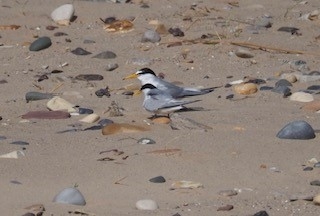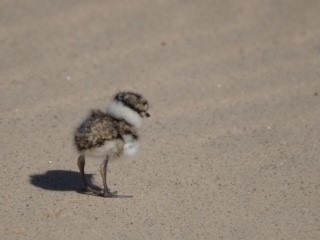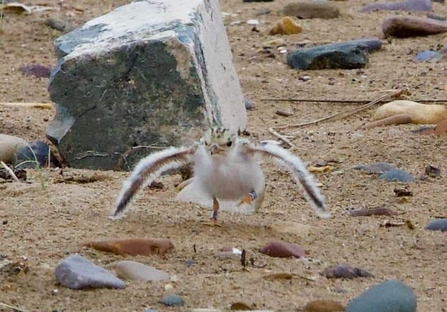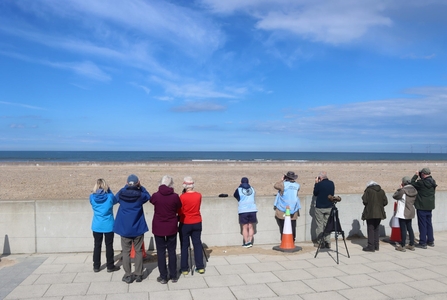The previous blog, from April this year, marked completion of preparations for the return of the little terns from Gambia. The fence had been erected and we had volunteers and wardens in place and ready to go. So it was all eyes skyward (and all fingers crossed) while we searched eagerly for our first arrivals. We need not have worried because our faithful feathered friends began to arrive and by the 1st May we had recorded the arrival of 34 little terns, with four pairs already grabbing the prime real estate for nesting within the site. As reflected in a great old northeast saying: ”shy bairns get nowt”.
The arrival of faithful feathered friends
Little Terns at Crimdon (c) Ian Turner

Early little tern prospectors (c) Emma
We also began to identify birds that had been ringed as chicks at their original base in Crimdon, one of which was dated back to 2009. It was 15 years old – and yet an even bigger surprise awaited us a few days later when, on the 2nd May, we found one of our Crimdon birds had returned to us at Seaton Carew, having been ringed as a chick in 2001 - twenty three years earlier! In that time, this little fellow will have flown approximately 138,000 miles on its trips to and from Seaton Carew each year. Out of interest, the record age recorded by the BTO is 25 years and 8 days. We’re rooting for another two years to enter the record books!
The little terns have continued to arrive throughout May and into June, reaching a top count of 193 individuals and in excess of 70 nests within the site. We’ve also been very happy to see a healthy population of ringed plovers who have thus far raised 16 chicks, with more to follow from yet more active nests. The chicks are obviously the crowd pleasers and lots of people have stopped by for a chat and to take advantage of telescopes and binoculars set up on the prom, although we often find that the ringed plover chicks venture very close to the prom wall, some would say exploring – I would say showing off. Pop along and our great team of wardens and volunteers would happily talk about the birds.

Ringed plover chick making an escape (c) Emma
Coming right up to date then, here in mid-June we are already seeing a great number of little tern chicks emerging from their shells and immediately stretching skyward in search for their first meal. Although at this young age they often struggle to swallow whole the sand eels ferried in regularly by one of the parent birds, quickly ducking back under the hen to brood, perchance to dream. The very first chick of the year emerged 8th June. And here he/she is 10 days later!

Our first little tern chick arrival, seen here at 10 days old. Photography courtesy of passer-by Peter Heal
To finish this blog, I’d like to give recognition to our amazing volunteers and wardens who give up so much of their time in devotion to these endangered little birds. They truly are incredible people who turn out in all weathers and all times of day to protect the site and monitor the development of the little terns, ringed plovers and their chicks. I’d also like to note the sterling efforts of the night shift wardens who brave the elements throughout the night in an effort to keep the local foxes away from the nesting birds and chicks. Of course none of this would be possible without the sponsorship and coordination on SeaScapes, Durham Wildlife Trust, Hartlepool Borough Council and Lottery funding.
Finally a big thank you to the general public and visitors to the site, many of whom travel long distances to witness what we are so fortunate to have here in Seaton Carew. The feedback and encouragement we have had means such a lot to everyone involved.
Thank you.

Wardens, volunteers and members of the public soaking up the little tern experience. Photo courtesy of volunteer Georgia



